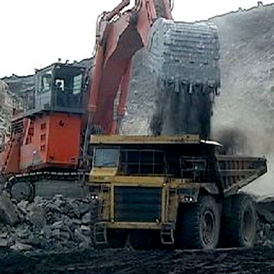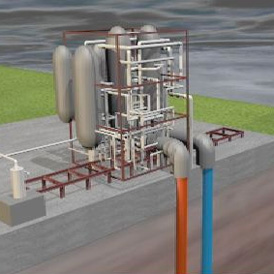Is the future of British coal burning it underground?
Take a boat out on Swansea Bay, and you’ll see a wind turbine spinning in the breeze as you leave the harbour. This is supposed to be the future of energy: green, clean and renewable, writes Ben King.
But beneath the waters of the bay lies another resource – coal. Mining in Wales is a shadow of its former self, but there are billions of tons of coal still left under the surface.
Rather than dig it all out the old-fashioned way, an entrepreneur is planning to generate energy by burning it where it sits, hundreds of metres below the surface.
The technology he hopes to use could make new coal resources across the world available for exploitation for the first time. A great new energy resource perhaps, but also a massive new source of climate-altering greenhouse gases.
Rohan Courtney believes that over one billion tons of coal lie beneath Swansea bay.
The man with his eye on Swansea Bay is Rohan Courtney. A veteran of the energy exploration game, he helped to turn a tiny oil company called Tullow Energy into one of Britain’s biggest companies, by exploiting neglected energy reserves in Africa and the North Sea.
He believes that over one billion tons of coal lie beneath Swansea bay. Later this year his company will start work on a project to drill into it and burn it.
Sending miners down under the sea would never be viable. But Mr. Courtney and his team think they can extract energy from that coal by partially burning it in situ, using a technique called underground coal gasification (UGC).

A plant on the shore will pump oxygen into the coal seams. If the supply is regulated carefully, the coal will only burn partially. This produces a gas, a mixture of carbon monoxide, methane and hydrogen, known as syngas.
The syngas is taken back to the surface, where it is either burned to produce electricity, or turned into liquid fuel such as diesel.
“This technique costs one third of the price of conventional coal,” Mr Courtney says. “And that’s being generous to coal.”
The power plant his company hopes to build would produce nearly enough energy to power the whole of Swansea, a town of over 230,000 people.
The plan may sound far-fetched, but the concept of UGC has been around for more than a century.
Read more: Should the UK put its foot down on a shale gas future?
Lenin was an enthusiast, and under his inspiration the Soviet Union experimented with UGC techniques in the 1920s. By the 1960s, several plants were in successful operation. One of them, in modern-day Uzbekistan, is still producing to this day.
Supporters of UGC believe it’s an idea whose time has come again. In recent years commercial plants have started in China and South Africa, with pilot projects in five other countries.
The Zeus Development Corporation, a research outfit which tracks UGC projects worldwide, has seen a doubling of the number of projects in the last two years. By its count there are now more than 60.
In Britain, licences for 18 projects have been issued by the Department of Energy and Climate Change. They range from Swansea to the Thames Estuary, ten more up the East Coast of England, four off the coast of Scotland, one off the Cumbrian coast, and another in Liverpool Bay.
“We have enough coal for underground coal gasification to provide energy, if that’s what we want to do, for hundreds of years,” says Mr Courtney.
There are two main reasons for this new wave of enthusiasm for UGC. High energy prices mean high potential rewards. And more importantly, new technology makes it much easier and cheaper to drill into underground coal seams.
Oil explorers have been hunting out small reserves for years – and they have developed remarkable technology for drilling holes sideways, for many kilometres, with extraordinary precision. New drill-bits can wiggle their way through long, twisting formations of rock, to follow seams of coal just a few metres deep.
This means that vast areas can be exploited from a single well-head above ground, greatly reducing the costs of UGC.
“Directional drilling is the main issue,” says Rohan Courtney.
“Directional drilling wasn’t around twenty years ago. And that’s changed the economics of this hugely.”
Fossil fuel pioneers have used this technology to find new sources of oil and gas, too – and enjoyed particular success in extracting natural gas from shale rocks. The supply of shale gas has been so plentiful that it now makes up a quarter of America’s gas production.
More from Channel 4 News: A new energy source for Britain?
Shale gas has ignited a giant environmental row, too, amid fears about the contamination of ground water. France has placed a moratorium on any shale gas drilling, and one of the sites of Britain’s first shale gas explorer has been invaded by protesters.
Not surprisingly, environmental protesters have expressed concerns about UGC as well. Not least in Australia, whose vast coal reserves have put it at the forefront of the new wave of UCG exploration.
In 2009 a project led by Cougar Energy, at Kingaroy in Queensland, was shut down by the state government after traces of benzene and toluene, potentially cancer-causing chemicals, were found in ground water near the plant.
Cougar denied that it had caused any pollution, and is counter-suing the Queensland Government. But it won’t be the last time a UCG project proves controversial.
Mr Courtney claims that his UCG project will be cleaner than burning conventional coal, as many of the pollutants, such as sulphur or mercury, will be left underground. To emphasise his point, his venture is named Clean Coal UK.
But arguably more significant than these localised concerns about pollution, will be the impact on the global climate of burning more coal and emitting more carbon dioxide.
Mr Courtney argues that the carbon dioxide his project generates can be buried back underground, and the gas produced by UGC projects is easier to bury than the output of conventional coal burning.

But the technology to put those gases underground – carbon capture and storage (CCS) – is far from commercially proven. Britain’s only CCS project collapsed last year, despite the offer of a £1bn government subsidy.
And if UGC takes off in emerging economies, notably India and China, the money and political will to develop CCS will be much less available than they are in Britain.
It is one of the ironies of the recent history of the energy business. Environmentalists hoped that the advance of technology would bring down the cost of renewable power, helping solar and wind to compete with fossil fuels on the open market.
But technological developments have also made it possible to tap new sources of non-renewable energy – be they gas, oil or coal – which were once thought to be too remote to exploit.
We’ve got more than enough fossil fuels to fry the planet several times over. Professor Dieter Helm
“We’ve got more than enough fossil fuels to fry the planet several times over,” says Prof. Dieter Helm, an energy economist from Oxford University.
“The earth crust is riddled with them, and this really is the climate change concern. What are we going to do if people burn all this stuff, given that it’s relatively cheap compared with some of the alternative low-carbon technologies?”
On Swansea Bay, that lone turbine on the harbour front keeps spinning away. Wind, at least, is something Wales is richly blessed with.
But it turns out that there’s still plenty of coal down there too. Which one will turn out to be the best way of keeping the lights on?